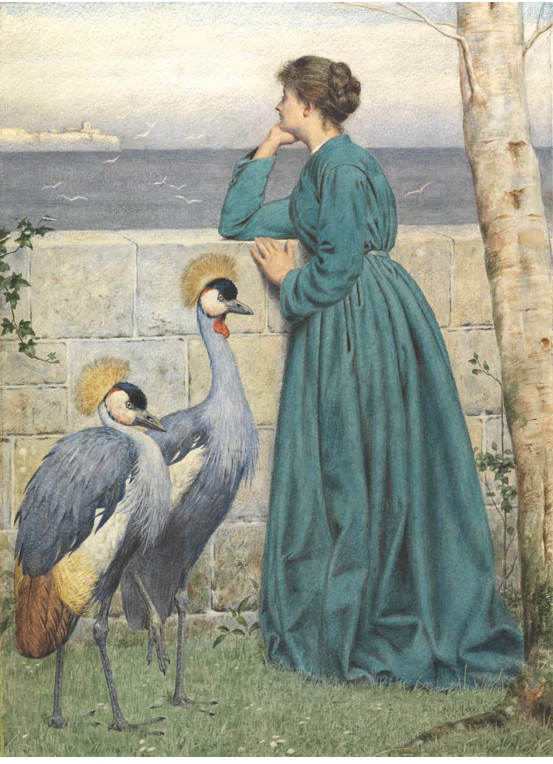Waiting and Watching
Henry Stacy Marks, RA (1829-1898)
Signed and dated 1854
Watercolour and bodycolour; signed
17 x 12 inches
The Maas Gallery, London
[Click on image to enlarge it.]
See commentary below.
The Maas Gallery has most generously given its permission to use in the
Commentary by Rupert Maas
Marks' dry and piquant humour endeared him to his friends and fellow artists. He was a frequent visitor to London Zoo, 'painting poultry' as a fellow RA put it. Marks wrote: 'I hope I may be excused, and not held too eccentric, in preferring to converse with a parrot for one hour, rather than with a politician for two.' In 1909, the critic Gleeson White prophesied that 'It would not be astonishing if [his pictures] retained the respect of future collectors long after many far more ambitious contemporary works ceased to charm.' The birds are Grey Crowned Cranes, about a metre high.
Artist biography
Henry Stacy Marks originally was trained to work in the family business – Marks & Co, Coachmakers, in Langham Place, London. However, he showed little aptitude for commercial work, and was allowed to study art. He first studied under the artist James Matthew Leigh [1808–1860] from 1847 and in January 1851 enrolled at the Royal Academy Schools. In 1852 Marks spent five months studying in Paris under François-Edouard Picot and at the Ecole des Beaux-Arts. The next year he made his début at the Royal Academy Summer Exhibition, where he exhibited annually until 1897. He was elected to the Royal Academy in 1878. Marks was a key member of the Saint Johns's Wood Clique, a group of historical genre painters of the 1860s and 1870s, who painted well researched scriptural, literary and historical scenes in a highly finished style. His dry and piquant humour endeared him to his friends and fellow artists, who called him 'Marco', and he was a notorious practical joker.
His early career was mixed; he sold a few paintings, received several portrait commissions, and spent a time as a drawing professor, and also as a glass painter at the firm that became Clayton & Bell. His reputation was established with the picture The Franciscan Sculptor and his Model (1860) which sold for £300, and commissions for paintings and frescoes followed. Science is Measurement was his diploma work for his RA in 1878. Many of his early pictures were on Shakespearian themes, but it is for his later pictures of birds that he is best known, many of them arising from work he did at London Zoo for the exhibition Birds in Bond Street (1889) by the Fine Art Society. Marks's pictures were typically light-hearted rather than weighty, and as Gleeson White correctly predicted in 1909, 'It would not be astonishing if [his pictures] retained the respect of future collectors long after many far more ambitious contemporary works ceased to charm'. Marks was influenced by the Pre-Raphaelites, in particular by their painstaking painting style and attention to detail. He was a friend of John Ruskin, who often went with him to London Zoo.
Victorian
Web
Visual
Arts
Painting
Artists
Created 10 February 2015
Last modified 19 November 2018
